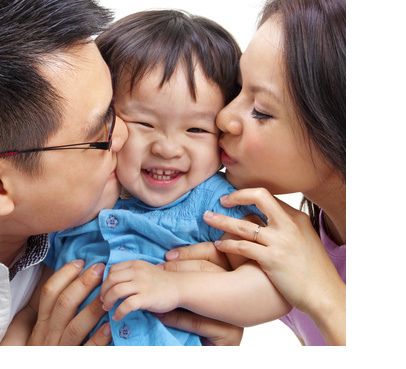When our baby was six months old, I couldn't walk down the street without stopping to accept a compliment. Baby was something of a local celebrity or a minor deity. Donuts, stickers, sunglasses, an invitation to the front of a line -- these were some offerings from the infant's admirers. Ten months have passed, and now she's a toddler. To me, she's as cute as ever, and she still receives planty of kisses and waves from strangers. But, I've got to face it -- she doesn't attract the solicitous stop-in-the-street simpering that she did in her first year.
How much longer until everyone stops thinking she's irresistibly adorable?
 This question happens to be the subject of a new study on children's faces. A trio of psychologists-- Lu Zhu Luo, Hong Li, and Kang Lee -- in China and at the University of Toronto, recruited 60 men and women and showed then a large sample of children's faces ranging from infants to 6-and-and-half-year-olds. The participants were asked to rate each face's likeability (How much do you like the face?) and attractiveness (How attractive is the face?). The researchers wanted to know if younger kids would be given higher attractiveness ratings than older kids -- and, if so, at what age is the cut-off happen between irresistibly adorable and merely cute?
This question happens to be the subject of a new study on children's faces. A trio of psychologists-- Lu Zhu Luo, Hong Li, and Kang Lee -- in China and at the University of Toronto, recruited 60 men and women and showed then a large sample of children's faces ranging from infants to 6-and-and-half-year-olds. The participants were asked to rate each face's likeability (How much do you like the face?) and attractiveness (How attractive is the face?). The researchers wanted to know if younger kids would be given higher attractiveness ratings than older kids -- and, if so, at what age is the cut-off happen between irresistibly adorable and merely cute?
The answer? The big drop-off in cuteness appears to happen around age 4 1/2 -- between preschool and kindergarten. Men and women rated infants as more likeable and more attractive than toddlers, who, in turn are rated as more attractive than young children.
What is it that happens to 4 1/2-year-olds?
Their facial structure changes, according to the Luo and his colleagues. Infants have a special set of features, such as a protruding forehead, a large head, a round face, big eyes, and a small nose or mouth. As a species, we have evolved to be attracted to these features and find them adorable. These cues make us feel soft and protective, whether or not we're biologically relatives -- which, in evolutionary terms, increases the likelihood of a baby's survival. (Indeed, studies have found that infants that have tiny eyes, flat foreheads, and square faces, for instance, are less likely to receive attention.) Our tendency to prefer infantile faces even extends to infant faces of other races.
Facial cranial growth is gradual, as is a child's independence from constant care-giving. Children's faces lose some of their universal babyish appeal right around the age that they don't need it anymore (to survive) -- early childhood. Incidentally, a four to five year interval may be the amount of time our hunter-gatherer foremothers waited before giving birth to their next baby.